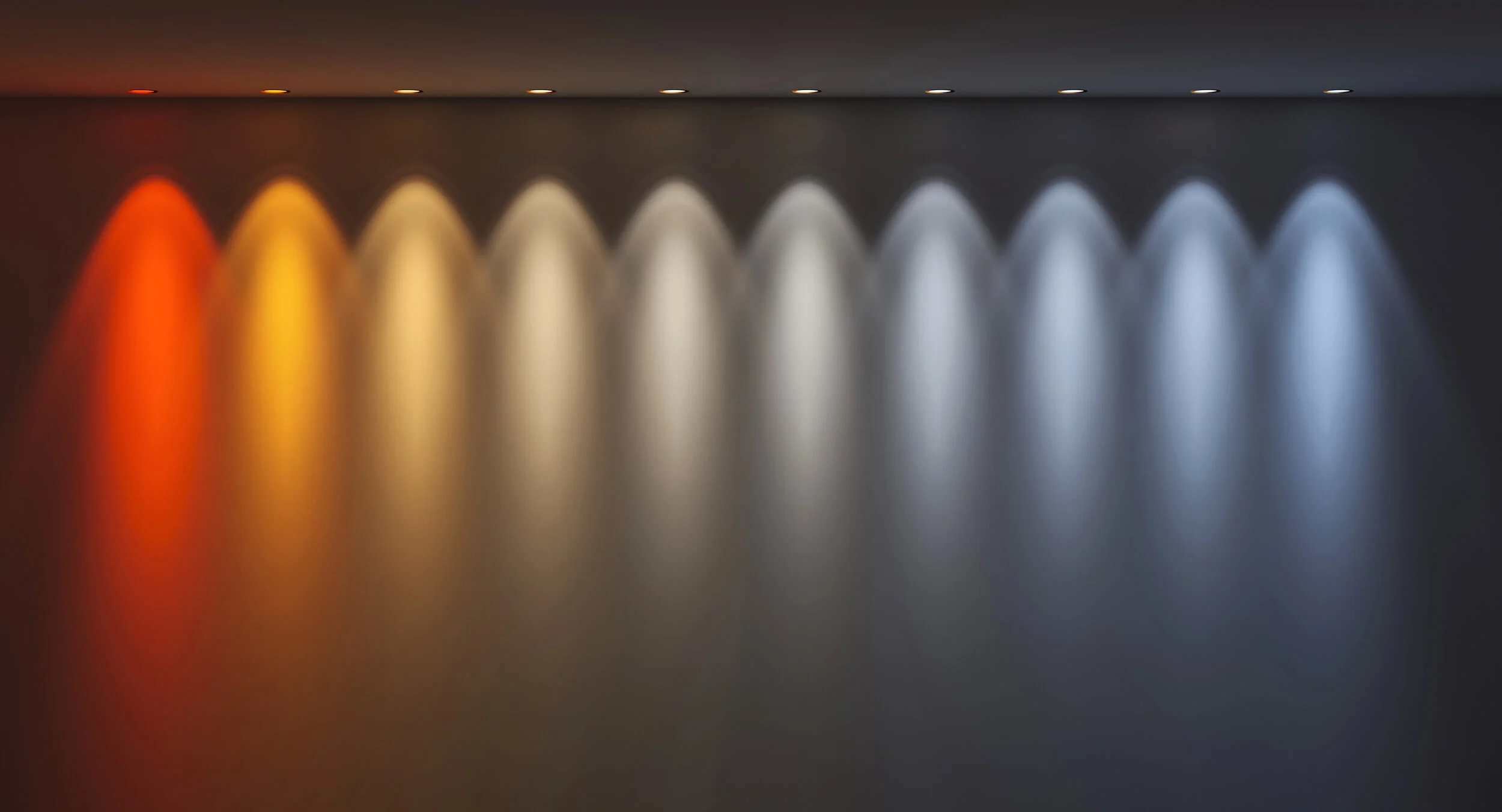We aren’t exposed to enough natural sunlight today.
After food and water, natural daylight is the most important element to sustaining human health and well-being. However, this presents a problem in today’s modern era since most people spend 90% of their time indoors, under artificial lighting.
Despite their best efforts, the lighting industry has fallen short of replicating the qualities of natural sunlight using traditional lighting technologies.
Lumen Impact is at the forefront of a revolution in artificial sun lighting.
Advances in our understanding of how light affects human physiology, LED (light emitting diode) technology, and wireless communications are enabling us to address the health—and business—implications of artificial light.
We call this Spectrally Enhanced Circadian Lighting (SECL).
In application, SECL is “indoor artificial sunlight” and mimics the five main characteristics of natural daylight:
Spectral distribution
Intensity
Timing
Duration
No flicker quality
Individually and combined, these five attributes have a major impact on our health, productivity, performance, and mental well-being as we strive to live our lives in the great indoors.

Spectral Distribution
The color of light affects our bodies and our environment in different ways.
The human eye can detect visible radiation—what most of us call light—in the range of 380 to 780 nm. This visible radiation is detected by structures in the eye called rods and cones, which are collectively referred to as photoreceptors.
The three separate cone photoreceptors detect red, green, and blue radiation which give us our color vision. These cones also detect yellow and green radiation. Dim monochromatic blue light (≈460 nm) is detected by the eye’s rod photoreceptors and give us our low light level vision.
Our eyes also contain primitive photoreceptors, known as intrinsically photosensitive retinal ganglion cells (IPRGCs), which are most sensitive to blue wavelength light (450 - 480 nm). To the observer, this light is referred to as “cool white” light (color temperature >5000K CCT) because it contains a high content of blue wavelengths.
This blue wavelength light is critically important to syncing our circadian clock system with the natural environment.
Figure 1: The eyes sensitivity under varying conditions: nighttime v'(λ), daylight conditions v(λ), and circadian effects c(λ)
In the morning hours, blue wavelength light stimulates the brain’s suprachiasmatic nuclei (SCN) to synchronize our circadian body clock with the natural environment. The SCN then signals the pineal gland to suppress the release of melatonin until the appropriate time of day.
Exposure to blue wavelength light has been correlated to increasing levels of visual acuity, body temperature, heart rate, and alertness.
However, blue wavelength is not always desirable. It is more detrimental than any other wavelength of light in the evening hours, as it can suppress or delay sleep.
To better reflect the way the wavelength of sunlight changes throughout the day, SECL manipulates the lighting spectrum.
It maximizes high blue wavelength spectrum in the morning hours while minimizing circadian stimulus light in the evening hours to promote sleep, health, and feelings of well-being.
Figure 2: Spectral Distribution of LED Light Sources vs. Natural Sunlight
Light as a Disinfectant
Recent clinical studies have demonstrated that violet–blue light, particularly 405 nm light, has significant antimicrobial properties against a wide range of bacterial and fungal pathogens and, although germicidal efficacy is lower than UV light, this limitation is offset by its facility for safe, continuous use in occupied and unoccupied environments. As a supplement to standard cleaning practices, violet-blue light is an effective anti-bacterial in against the following bacterial and fungal pathogens:
Gram Negative
Staphylococcus aureus (including MRSA)
Clostridium perfringens
Clostridium difficile
Enterococcus faecalis
Staphylococcus epidermidis
Staphyloccocus hyicus
Streptococcus pyogenes
Listeria monocytogenes
Bacillus cereus
Mycobacterium terrae
Lactococcus lactis
Lactobacillus plantarum
Bacillus circulans
Streptococcus thermophilus
Acinetobacter baumannii
Pseudomonas aeruginosa
Gram Positive
Klebsiella pneumoniae
Proteus vulgaris
Escherichia coli
Salmonella enteritidis
Shigella sonnei
Serratia marcescens
Salmonella typhimurium
Bacteria Endospores
Bacillus cereus
Clostridium difficile
Yeast & Filamentous Fungi
Aspergillus niger
Candida albicans
Saccharomyces cerevisiae
Intensity
Figure 3: Melatonin suppression begins at 30 lux and saturates at ca 1000 lux at eye level
Any light at night can impact our sleep.
This is because light—especially blue wavelength light—can trigger the suppression of the body’s production of melatonin, the “sleep hormone”.
Research indicates that even low levels of light (~150 lux which is equivalent to a dimly lighted hallway) can impact our circadian rhythm and stimulate alertness.
SECL is designed to optimize the spectral power distribution of light at all times of the day.
This helps to minimize glare and energy consumption while creating an optimal level of light that promotes performance, health, and sleep.
Spectral Timing & Duration
Figure 4: Human physiology is significantly impacted by the color and timing of light exposure
The time of day influences the non-visual impacts of light.
Light has a huge impact on human physiology. Blue wavelength morning light syncs our biological clock and tells our bodies that the day has begun. Conversely, light at night makes it more difficult to sleep by suppressing or delaying melatonin production.
Spectrally Enhanced Circadian Lighting mimics natural daylight indoors based upon the sun’s spectral distribution at any time of day.
SECL automatically provides high intensity, blue-enriched light in the late morning.
However, indoor occupants can always deviate from this automatic control to optimize the light’s output to match the desired outcome.
The color temperature & intensity of Spectrally Enhanced Circadian Light can be adjusted to create positive outcomes on building occupants.
A teacher may want to elevate student performance during testing by raising the color temperature and intensity of the lights.
A 24-hour call center supervisor may want to stimulate alertness of the employees (while not disrupting their circadian rhythm) by increasing the red wavelength duration and intensity the light at night.
A senior living center can influence Alzheimer and dementia patients to be calmer in the day and sleep through the night by exposing the patients to a strong dose of blue wavelength light in the morning hours.
An office manager may want to stimulate employees after lunch through a short duration of high intensity blue wavelength light.

No-Flicker Quality
According to the US Department of Energy, the vast majority of LED lighting products exhibit an unacceptable level of flicker.
Flicker is the visible or non-visible strobing of artificial light sources.
You may remember when visible light flicker was common in facilities lighted with fluorescent lights. These lights used T12 lamps and magnetic ballasts. Slowly, flicker disappeared as fluorescent lighting was transitioned to T8 lamps using high frequency electronic ballasts.
Unfortunately, flicker is back with a vengeance today as fluorescent lighting is being retrofitted with LED lighting—powered by low cost, low frequency drivers—the vast majority of LED lamps installed today.
Flicker can lead to:
Epileptic seizures
Headaches &migraines
Eye strain
Fatigue
Safety hazard for workers operating machinery
Increased manufacturing production scrap and/or quality issues
Even non-visible flicker can impact our health and well-being by entering our eyes, reaching our retinas, traveling the neural circuitry of our central nervous system, and then entering our brain and impacting our functioning (Figure 5).
In short, flicker can present a silent (and most of the time invisible) problem.
Figure 5: Visible and Non-visible Flicker
Not everyone is affected by light flicker in the same way.
The exact percentage of the population affected by flicker is hard to measure. This is because the central nervous system reacts differently to visual inputs from person to person. The problem is additionally compounded by differences in visual acuity, age, and body chemistry. As a result, the IEEE and US Department of Energy recommends that the flicker level be less than 10% for health and safety.
Research studies also indicate that 1 in 4000 individuals are prone to photo sensitive epileptic seizures (light sensitive seizures). This equates to .025% of the world’s population.
So why worry about flicker, especially if only 1 in 4000 individuals go into a photo epileptic seizure?
First, a light induced seizure could easily happen on your property and carry with it a legal and financial liability. It isn’t worth the risk.
Second, the health problems induced by flicker—fatigue, headaches, migraines, etc—that can affect your employees carry real organizational costs, such as lost productivity and absenteeism.
Finally, numerous studies claim an 8% increase in work productivity in flicker-free workplaces. These same studies indicate a 33% increase in feelings of well-being and engagement.
Our Spectrally Enhanced Circadian Lighting utilizes ultra-low flicker technology, providing the benefits of LED circadian lighting without the side effects of flicker.
The result is a technology that pays dividends to employee productivity and your bottom line.
Spectrally Enhanced Circadian Lighting has a promising future.
In October 2018 three scientists won the Nobel Prize for examining the molecular mechanisms controlling the circadian clock and the impact of light. Clearly, the development of productive and healthy outcomes based on environments that are adjusted to circadian rhythms is just beginning.
It’s important for organizations to consider the impact of SECL in the long run, as there are many exciting potential prospects. For example:
An MIT study found that a healthy circadian rhythm may help guard against age-related diseases such as hypertension and Parkinson’s.
New dietary approaches based on circadian timing for meals can benefit patients.
Blue light can reduce the biological clock disruption that occurs after anesthesia and surgery.
Using visible violet-blue light, not harmful to humans, as an effective continuous anti-bacterial and anti-fungal.
As patients enjoy improved sleep, well-being, quality of life; as medical staff experience increased performance, energy and productivity; and as organizations find multiple financial and human resource benefits, the future seems positive for all.





